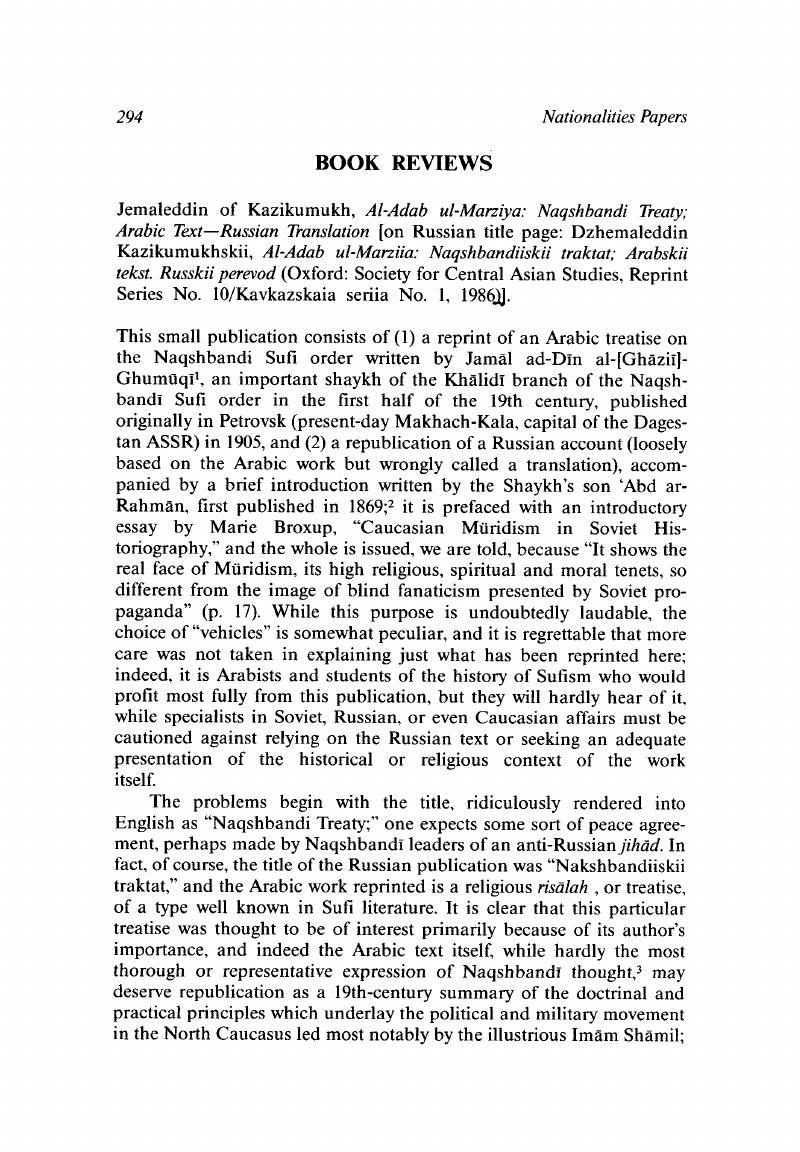No CrossRef data available.
Article contents
Jemaleddin of Kazikumukh, Al-Adab ul-Marziya: Naqshbandi Treaty; Arabic Text—Russian Translation [on Russian title page: Dzhemaleddin Kazikumukhskii, Al-Adab ul-Marziia: Naqshbandiiskii traktat; Arabskii tekst. Russkii perevod (Oxford: Society for Central Asian Studies, Reprint Series No. 10/Kavkazskaia seriia No. 1, 1986)].
Published online by Cambridge University Press: 20 November 2018
Abstract

- Type
- Book Reviews
- Information
- Copyright
- Copyright © 1990 Association for the Study of Nationalities of Eastern Europe
References
Notes
1. In the text itself (p. 2) he calls himself simply “al-Ghumūqī;” on the title page of the 1905 publication he is called “al-Ghāzī-ghumūqī,” indicating that he was a native of Ghāzī-Qumuq, a leading political and religious center of Daghestan. The name was Russianized as “Kazi-kumuk,” and in works indebted to Russian writings he is thus styled “Kazikumukhskii.Google Scholar
2. It appeared in section III (entitled “Uchenie o tarikate”) in Sbornik svedenii o Kavkazskikh gortsakg, vol. II (Tiflis, 1869), pp. 2-22; the second half of section III (pp. 23-48), entitled “Tarikatskie legendy, poucheniia i pis'ma,” was not included in the reprint.Google Scholar
3. Interestingly, the author consistently refers to his tarīqah as the Naqshbandīyah, ignoring (or perhaps consciously avoiding) the tendency, quite common in the 19th century, to replace, or at least append to, the name of the “original” tarīqah the name of the founder of a sub-order (e.g. “Mujaddidīyah”). Jamal ad-Dīn himself belonged to the silsilah of the pivotal Naqshbandī-Mujaddidī Shaykh Khālid (d. 1827), whose spiritual descendants stressed his preeminence by “re-naming” the order “khālidīyah” (see Albert Hourani, “Shaikh Khalid and the Naqshbandi Order,” in Islamic Philosophy and the Classical Tradition, ed. S.M. Stern et.al. (Columbia: University of South Carolina Press, 1973), pp. 89-103); a closer study of the treatise reprinted here might shed light on whether the North Caucasian branch consciously sought in some way to evoke an earlier, “purer” Naqshbandī teaching.Google Scholar
4. The editorial board of the original 1869 publication claims (reprint, p. 20) that the translation preserved “the literal sense of nearly every phrase of the original work,” suggesting that the son's abridgment was already far removed from Jamāl ad-Dīn's original; but the Russian version betrays a much less well-informed sensitivity to the order's doctrine and silsilah than one might expect from the shaykh's son (as is confirmed by the largely worthless notes provided by the translater), and it seems likely that this claim is rather exaggerated.Google Scholar
5. For example, those familiar with Russian transcription conventions may recognize Khoja Yūsuf Hamadānī in “Iusuf Gamadanskii” or Shaykh Sarī Saqatī in “Siry Saktinskii,” but it will be difficult to reconstruct Mahmūd Anjīr Faghnavī from “Makhmud-Indzhir Gafnaviiskii” or Abū ‘Alī Fārmadī from “Abu-Ali Garmadiiskii” (the latter forms indicate errors in transcription from the Arabic-script text, further attesting to the “translator's” unfamiliarity with his subject); likewise, the predecessor of Shāmil is referred to as “Kazi-Magomed,” where from one might conclude that he served as a qāzī (“judge”) rather than as a ghāzī (“fighter for the faith”). And one cringes to think that the forms “khavadzha,” “khovadzha,” and “khavadzhikat” (the latter incorrectly transcribed from the original publication's “khavadzhikan,” for the Persian plural khojagān) might appear in subsequent writings with the imprimatur of the Society for Central Asian Studies.Google Scholar




